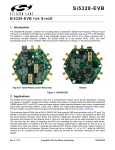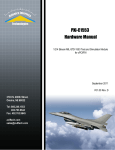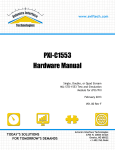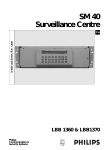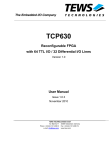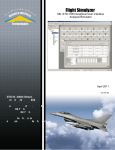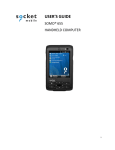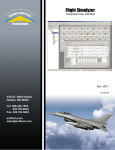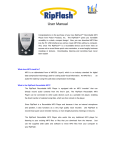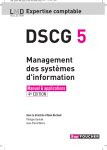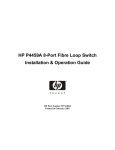Download Hardware Manual APG-FC2/4 - Avionics Interface Technologies
Transcript
APG-FC2/4 Hardware Manual Dual Port Fibre Channel Simulator/Analyzer Interface Test Module for PCI/PCI-X September 2010 V03.00 Rev. A 3703 N. 200th Street, Omaha, NE 68022 Tel: 866.246.1553 402.763.9644 Fax: 402.763.9645 aviftech.com [email protected] APG-FC2/4 Hardware Manual Dual Port Fibre Channel Simulator/Analyzer Interface Test Module for PCI/PCI-X September 2010 V03.00 Rev. A I APG-FC-X Hardware Manual Table of Contents ....................................................................................................1 Section 1 INTRODUCTION 1.1 General.................................................................................................................... 1 1.2 How This .................................................................................................................... 2 Manual is Organized 1.3 Applicable .................................................................................................................... 2 Documents 1.3.1 Industry Documents ...................................................................................................... 2 1.3.2 Product Specific ...................................................................................................... Documents 3 1.3.3 Fibre Channel ...................................................................................................... Related Books 3 ....................................................................................................4 Section 2 STRUCTURE OF THE APG-FC4 2.1 FPGA .................................................................................................................... 7 2.2 PowerPC .................................................................................................................... 8 RAM 2.3 Scalable .................................................................................................................... 8 Memory 2.4 Port Bypass .................................................................................................................... 8 2.5 Time Sunchronization .................................................................................................................... 8 2.6 Power Supply .................................................................................................................... 8 Circuitry 2.7 Transparent .................................................................................................................... 8 PCI Bridge 2.8 PCI Edge .................................................................................................................... 8 Connector ....................................................................................................9 Section 3 EXTERNAL INTERFACES 3.1 Front Panel .................................................................................................................... 9 LEDs 3.2 SFP Fibre .................................................................................................................... 10 Channel Interface 3.3 I/O Interfaces .................................................................................................................... 10 for Timing and Triggers ....................................................................................................17 Section 4 TIME SYNCHRONIZATION OPERATION (PRELIMINARY) 4.1 Time Synchronization .................................................................................................................... 17 Methods 4.2 Internal .................................................................................................................... 20 Board-to-Board Timer-Sync Connector and Switches ....................................................................................................23 Section 5 BOARD LOGIC DESCRIPTION APG-FC-X Hardware Manual II 5.1 IRIG Encoding/Decoding .................................................................................................................... 23 5.2 PCI/PCI-X .................................................................................................................... 23 Interface 5.3 Port Logic .................................................................................................................... 24 5.3.1 PowerPC ...................................................................................................... 24 5.3.2 SERDES Interface ...................................................................................................... 25 5.3.3 Analyzer ...................................................................................................... 25 5.3.4 Generator ...................................................................................................... 26 5.3.5 Media Access ...................................................................................................... Controller (MAC) 26 ....................................................................................................27 Section 6 TECHNICAL DATA Section 7 NOTES ....................................................................................................30 7.1 Abbreviations .................................................................................................................... 30 and Acronyms III APG-FC-X Hardware Manual 1 INTRODUCTION 1.1 General This APG-FC4 Hardware Manual defines the board connections, a general description of the hardware architecture and technical data for the APG-FC4 Simulyzerämodule for PCIbus and PCI-Xbus. For installation of the APG-FC4 and associated Software Development Kit (SDK), please see the APG-FC4 Getting Started Manual. The APG-FC4 Simulyzerä module is a member of AIT’s family of high performance, intelligent Fibre Channel interface modules that offer full function testing, data generation/simulation and monitor/analyzer functions. The APG-FC4 modules have been developed to operate in-line or as a Node in Point-to-Point, Switched Fabric and Arbitrated Loop topologies. The APG-FC4 offers onboard processing, scalable memory resources, IRIG encoder/decoder and high speed protocol deciphering. The advanced hardware architecture uses a Xilinx Virtex-II PRO which includes two Power PCs (PPC) (one for each Fibre Channel port). The dual ports function independently or can be configured to work together for a variety of specific modes of operation. A powerful PCIController and Memory Arbiter is realized in a Field Programmable Gate Array (FPGA). The FPGA supports the interface to the application, the software tasks running the host computer and assists the communication for data transfer. The IRIG encoder/decoder on the APG-FC4 board satisfies the requirements of ‘multi-channel time tag synchronization' on a system level. The APG-FC4 is available in one of the following options: APG-FC4-xGB · Dual Port Fibre Channel Simulyzer™, simultaneous Simulator and Analyzer for 4 Gbps data rates respectively. · Memory: x = 1 GB, 2 GB, 4 GB RAM So-Dual Inline Memory Modules (DIMMs) (half per port) APG-FC4-DC-xGB · Dual Port Fibre Channel Simulyzer™ plus Data Corruptor™ for 4 Gbps data rates respectively. · Memory: x = 1 GB, 2 GB, 4 GB RAM So-DIMMs (half per port) APG-FC4-SF-xGB · Dual Port Fibre Channel Single Function interface module, programmable to either Data Generator/Monitor or Analyzer for 4 Gbps data rates respectively. · Memory: x = 1 GB, 2 GB, 4 GB RAM So-DIMMs (half per port) APG-FC-X Hardware Manual 1 DOCUMENT HISTORY 1.2 Version V1.00 Rev. B V1.00 Rev. C V2.00 Rev. A Cover Date January 2005 March 2005 August 2005 V3.00 Rev. A September 2010 Created by S. Lindsay S. Lindsay N. Kragick/ D. Dingeman M. Amarawardana Description Creation of document Apply new format Added 4G information/ edited format Update technical specifications/apply new format How This Manual is Organized This hardware manual is comprised of the following sections: Section 1, INTRODUCTION, contains an overview of this manual Section 2, STRUCTURE OF THE APG-FC4, describes the main components, connector pinouts and logic functionality Section 3, EXTERNAL INTERFACES, describes the faceplate I/O status and connectors including pin out description Section 4, TIME SYNCHRONIZATION OPERATION, describes the methods and connectivity required to synchronize the timing for multiple APG-FC4 modules Section 5, BOARD LOGIC DESCRIPTION, provides a high level overview of the board functionality and logic interfaces Section 6, TECHNICAL DATA, provides technical specifications of the APG-FC4 Section 7, NOTES, Abbreviations and Acronyms 1.3 Applicable Documents The following documents shall be considered to be a part of this document to the extent that they referenced herein. In the event of conflict between the documents referenced and the contents of this document, the contents of this document shall have precedence. 1.3.1 Industry Documents The following American National Standards Institute (ANSI) Fibre Channel specifications were used to develop the APG-FC4 module design. · FC Arbitrated Loop, ANSI X3.272:1996 · Fibre Channel Framing and Signaling Interface, ANSI/INCITS 373:2003 2 APG-FC-X Hardware Manual · · · · 1.3.2 Fibre Channel Framing and Signaling-2, T11/05-190v3 draft FC Generic Services, ANSI X3.288:1996 Fibre Channel 2nd Generation Generic Services, ANSI NCITS 288 Fibre Channel - Switch Fabric – 2, ANSI/NCITS 355-2001 Product Specific Documents AIT has developed documents that may aid the user with other aspects of the APG-FC4 Fibre Channel module. These documents and a summary of their contents are listed below: · APG-FC4 Getting Started Manual, assists the first time users of the AIT APG-FC4 boards and fcXplorer graphical user interface with software installation, hardware installation and starting a sample host application project · APG-FC4 Software Library Reference Manual for Windows and Linux Applications, provides the user with detailed APG-FC4programming information including Application Interface function calls, header file details and Sample Program descriptions · fcXplorer User's Manual, provides definition and step-by-step instructions on how to use fcXplorer, the Fibre Channel Simulator and Analyzer Test Software for Windows, fcXplorer provides a Graphical User Interface to setup and control the APG-FC4 1.3.3 Fibre Channel Related Books · Fibre Channel; A Comprehensive Introduction, Robert W. Kembel, Northwest Learning Associates, 3061 N. Willow Creek Drive, Tucson, AZ 85712. See www.nlabooks.com. · The Fibre Channel Consultant: Arbitrated Loop, Robert W. Kembel, Northwest Learning Associates, 3061 N. Willow Creek Drive, Tucson, AZ 85712. See www.nlabooks.com. · The Fibre Channel Consultant: Fibre Channel Switched Fabric, Robert W. Kembel, Northwest Learning Associates, 3061 N. Willow Creek Drive, Tucson, AZ 85712. See www.nlabooks.com. APG-FC-X Hardware Manual 3 2 STRUCTURE OF THE APG-FC4 The APG-FC4 module architecture consists of the following main components as described in the following sections: · · · · · · · · Field Programmable Gate Array (FPGA) Power PC RAM Scalable Memory Port Bypass Time Synchronization Power Supply Circuitry Transparent PCI Bridge PCI Edge Connector Figures 2-1 and 2-2 provide an overview of the hardware architecture for the APG-FC4 DSUB and MOD8 configurations respectively. Figures 2-3 and 2-4 show the main components of the APG-FC4 DSUB and MOD8 configurations respectively. 4 APG-FC-X Hardware Manual Figure 2-1 APG-FC4 Hardware Architecture (DSUB Configuration) APG-FC-X Hardware Manual 5 Figure 2-2 APG-FC4 Hardware Architecture (MOD8 Configuration) 6 APG-FC-X Hardware Manual Figure 2-3 APG-FC4 Board Hardware Overview (DSUB Configuration) Figure 2-4 APG-FC4 Board Hardware Overview (MOD8 Configuration) 2.1 FPGA The FPGA on the APG-FC4 contains the port logic for both Fibre Channel ports and glue logic for connecting together the board components. Each port is equipped with a 32-bit PowerPC processor for running customer applications and some of the Fibre Channel port logic (loop initialization, etc.) APG-FC-X Hardware Manual 7 2.2 PowerPC RAM Each port on the APG-FC4 has dedicated memory for its PowerPC processor. This memory stores the data, instruction, heap and stack segments for user programs and the application interface. 2.3 Scalable Memory The APG-FC4 can be configured with 512MB, 1 GB, or 2 GB of RAM per port. The APG-FC4 can additionally be configured with 4 GB of RAM per port. This RAM is used for user transmit data and monitor data. 2.4 Port Bypass The APG-FC4 provides an external bypass for incoming data, so that data coming in one port may be repeated out the second port without passing through the FPGA. This provides the lowest possible latency from the input to the output on the card while maintaining signal integrity. Both cards will wrap the data internally as well, which increases latency but improves the transmitted signal quality. 2.5 Time Sunchronization Both an IRIG encoder and decoder are included on the APG-FC4 card. This circuitry is used to synchronize multiple APG-FC4 cards together in the system, and to synchronize timestamps with other IRIG-B cards in a larger system. On the APG-FC4, this time synchronization circuitry is part of a daughter card. See Section 4 for more information regarding configuration of timing interfaces for multiple APG-FC4 boards. 2.6 Power Supply Circuitry Power is supplied from the +5V and +12V rails of the PCI edge connector. All other required voltages are generated on the board using DC-DC Converters. 2.7 Transparent PCI Bridge The transparent PCI bridge isolates the FPGA from the system PCI bus or PCI-X bus. This allows the APG-FC4 to operate in both + 5V and +3.3V PCI signaling environments. 2.8 PCI Edge Connector The PCI edge connector is keyed for both +3.3V an +5.0V signaling environments. On the APG-FC4, this interface is strapped to identify the card as a 133 MHz 64-bit PCI-X device. 8 APG-FC-X Hardware Manual 3 EXTERNAL INTERFACES The APG-FC4 faceplate provides external interfaces for the following: · · · · Status LEDs SFP Fibre Channel interface I/O Interface for triggers and IRIG-B Timing interface for synchronization of multiple boards (APG-FC4 only) Figures 3-1 and 3-2 show the APG-FC4 DSUB and MOD8 faceplate configurations respectively. 3.1 Front Panel LEDs Each port has four status LEDs located on the faceplate adjacent to its corresponding SFP socket, port 0 and port 1. Table 3.1-I describes the LEDs. Table 3.1-1 LED Descriptions LED Name SIGNAL DETECTED Color Yellow LINK ACTIVE Yellow Tx/Rx FRAME Yellow LINK ERROR Red Description Indicates the port is detecting light on the Fibre Channel interface Indicates success of the initialization of the port sequence for either Point-toPoint (N_Port) or Arbitrated Loop Topology (L_Port) Indicates the port is transmitting or receiving frames Indicates the port has detected FC1 or FC2 errors on the receiver APG-FC-X Hardware Manual 9 Figure 3.1-1 APG-FC4 DSUB Faceplate Figure 3.1-2 APG-FC4 MOD8 Faceplate 3.2 SFP Fibre Channel Interface The APG-FC4 module utilizes two Small Form-factor Pluggable (SFP) sockets (port 1 and port 2) located on the front panel. These sockets accept either wire (copper) or fiber transceivers. The AIT-provided optical transceivers employ modular LC™ connectors and are powered by a single 3.3 V power source supplied by the board. The wire transceivers are available in a variety of connectors. 3.3 I/O Interfaces for Timing and Triggers Each APG-FC4 board contains an I/O connector (DSUB-26 pin connector or an RJ45 connector) on the faceplate for timing and trigger interfaces. This section describes the timing and I/O interface for each board type. The APG-FC4 is available in two configurations that support different I/O connections as follows: · APG-FC4 with High Density DSUB-26 pin female connector - All IRIG, timer 10 APG-FC-X Hardware Manual sync, and trigger inputs/outputs are routed through this connector. The connector pin outs are shown in Figure 3.3-2. · APG-FC4 with two 8-pin RJ45 female connectors - Only sync and trigger inputs/outputs are routed through these connectors. (IRIG is not available using these connectors.) The connector pin outs and RJ45 signal I/O schematic are shown in Figure 3.3-3. These connectors use standard CAT5 UTP (EIA/TIA-568A) cables for timing interconnections. Shielded cables can also be used to keep magnetic radiation to a minimum. To keep timing skew to a minimum, use as short a cable as is practical. Note: Trigger outputs will also be connected to the next modules trigger inputs and will not be daisy chained, even when switches are in daisy chain position. Switches on the I/O connector circuit board determine if the second connector (Connector B) is an output connector or is wired in parallel with the input connector for daisy chaining the sync signals. (trigger outputs are still outputs and are not changed by the switch.) The first module in the chain (usually master) must be set to 'Output'. All other modules can be set to 'Daisy' (up to 15 modules). If more than 15 are chained, number 15 should be set to 'Output' to buffer the signals for the next modules. See Section 4 for further information regarding synchronization of timing. APG-FC-X Hardware Manual 11 Figure 3.3-1 APG-FC2 External I/O Interface Looking into panel DSUB connector Pin No.Signal 1NO CONNECT 2NO CONNECT 3NO CONNECT 4TRIG1_IN GND 5TRIG1_IN 6NO CONNECT 7NO CONNECT 8+12 VDC GND 9NO CONNECT 10+12 VOLTS 11NO CONNECT 12NO CONNECT 13TRIG0_IN 14TRIG0_IN GND 15TRIG1_OUT 16TRIG1_OUT GND 17IRIG_IN 18IRIG_IN GND 19NO CONNECT 20NO CONNECT 21TRIG0_OUT GND 22TRIG0_OUT 23NO CONNECT 24NO CONNECT 25IRIG_OUT GND 26IRIG_OUT 12 APG-FC-X Hardware Manual Figure 3.3-2 APG-FC4 with DSUB 26-pin External I/O Interface Looking into panel DSUB connector Looking above DSUB connector APG-FC-X Hardware Manual 13 Pin No.Signal 1SYNC_CLK_OUT_N 2SYNC_CLK_OUT_P 3SYNC_NRZ_IN_P 4SYNC_NRZ_IN_N 5TRIG1_IN_P 6TRIG1_IN_N 7SYNC NRZ_OUT_P 8SYNC NRZ_OUT_N 9NO CONNECT 10Vdd (strappable - factory default 5.0 volts) for auxiliary use only (normally unused) 11GND 12GND 13TRIG0_IN_P 14TRIG0_IN_N 15TRIG1_OUT_P 16TRIG1_OUT_N 17IRIG_IN_P 18IRIG_IN_N 19SYNC_CLK_IN_N 20SYNC_CLK_IN_P 21TRIG0_OUT_N 22TRIG0_OUT_P 23SYNC_PULSE_IN_N 24SYNC_PULSE_IN_P 25IRIG_OUT_N 26IRIG_OUT_P 14 APG-FC-X Hardware Manual Figure 3.3-3 APG-FC4 with RJ45 External I/O Interface Pin No. 1 2 3 4 5 6 7 8 A Signal (Input) SYNC_CLK_IN_N SYNC_CLK_IN_P SYNC_NRZ__IN_N TRIG0_IN_P TRIG0_IN_N SYNC_NRZ_IN_P TRIG1_IN_N TRIG1_IN_P B Signal (Output) (S1 ON S2 OFF) SYNC_CLK_OUT_N SYNC_CLK_OUT_P SYNC_NRZ_OUT_N TRIG0_OUT_P TRIG0_OUT_N SYNC_NRZ_OUT_P TRIG1_OUT_N TRIG1_OUT_P B Signal (Daisy) (S1 OFF S1 ON) SYNC_CLK_IN_N SYNC_CLK_IN_P SYNC_NRZ_IN_N TRIG0_OUT_P TRIG0_OUT_N SYNC_NRZ_IN_P TRIG1_OUT_N TRIG1_OUT_P APG-FC-X Hardware Manual 15 16 APG-FC-X Hardware Manual 4 TIME SYNCHRONIZATION OPERATION (PRELIMINARY) When multiple APG-FC4 boards are contained in a system, synchronization of the timing signal is important when comparison of capture logs is required and/or synchronization of module processes are required. The time stamps saved in the capture log are derived from a set of counters running inside the FPGA. Two counters are used, a Most Significant Bits (MSB) counter and a Least Significant Bits (LSB) counter. The MSB counter holds the day/hour/minute/seconds and is loaded by the IRIG decoder or manually by the user. The Least Significant Bits (LSB) counter holds fractions of seconds. Synchronization of the timing counters will occur every second except while the Chronological monitor is actively capturing data. Synchronization will cause the LSB counter to be reset to 0 by the sync signal (either the external IRIG signal or timer sync signal), or by a manual load. The time stamp format is shown in Table 4-I Table 4-1 Time Elements and Bits Time Element DAYS of Year HOURS of Day MINUTES of Hour SECONDS of Minute NANOSECONDS of Second (10 ms) 4.1 Number of digits 3 2 2 2 5 Time Synchronization Methods The APG-FC4 provides two methods for synchronizing the time for multiple boards in a system as follows: · IRIG-Modulated Square Wave - the IRIG modulated square wave generated by the logic in the FPGA on the master module can be used as input to each of the other IRIG inputs on the slave modules. An external IRIG-B signal, the host system clock or user-provided time can be used as the time source for the master module. When an IRIG input signal is present, a 100 MHz IRIG PLL will be locked to the IRIG carrier. Time delay from connector, through the IRIG circuitry and to the time registers is nominally 170 ns with signal level of 0.2 to 2 volts p-p and then rises to 280 ns at 10 volts p-p. If the IRIG signal is a sine wave, the slow rise time will result in additional time skew (usually more delay due to hysteresis in comparators). Noise on the signal will result in increased timing jitter that is exacerbated by the slow rise time of a sine wave through the comparator threshold. The higher the signal level a sine wave has, the faster the rise time is and the better the signal to noise ratio. So it is best to use a level APG-FC-X Hardware Manual 17 of 2 to 3 volts pp if available. For this reason, the IRIG output from the modules is an amplitude modulated square wave instead of a sine wave. The fast rise and fall times virtually eliminate this component of skew and minimize impact of noise. Using daisy chaining from the master to the slaves on the square wave IRIG time-sync signal will result in the master being approximately 170 ns ahead of the slaves, and the slaves should be within 20 ns of each other. The units are phase locked to each other and the IRIG source, so skew is the only source of timing error in addition to the inaccuracy of the IRIG source. When no IRIG signal is present, or the module is set for internal timing, the IRIG PLL is configured to free run at 100 MHz with a 100 ppm tolerance. · SYNC_CLK and SYNC_NRZ signals - the SYNC_CLK and SYNC_NRZ signals generated by the logic in the FPGA on the master module can be used as inputs to each of the other SYNC_CLK and SYNC_NRZ signal inputs on slave modules. This is the preferred method of synchronization for all APG-FC4 installations. · SYNC_CLK - 10 MHz square wave 3ns (tentative) skew from clock source, rising edge is time sync aligned, falling edge is clock for SYNC_NRZ. (used for nanoseconds resolution.) · SYNC_NRZ - 10 Mbps NRZ signal containing the MSB counter (used for seconds resolution) 18 APG-FC-X Hardware Manual The interconnection of multiple modules is implemented using the DSUB or RJ45 connector on the faceplate (as described in Section 3.3) or the connector on the top edge of the Timer-Sync board (for internal connection only on APG-FC4) (or both connection methods in the case of multiple groups of modules). Figure 4.1-1 provides an example of multiple groups of APG-FC4 modules connected to one external time source (either IRIG-B or SYNC_CLK). One module in the system is set up as a master and the rest are set up as slaves or as sub masters. (Table 4.1-I provides a description of the APG-FC4 module hierarchy terminology used in the timing synchronization example.) Table 4.1-1 Timing Synchronization Example Terminology Module Hierarchy Master Module Sub-Master Module Slave Module Description A module configured and wired to take a time reference such as an IRIG input or external or internal quartz referenced clock and generate the time sync signal(s). Normally a system would have a single Master Module. A module configured and wired to buffer time sync signals for use by itself and Slave. There is actually no configuration difference between a Sub-Master and a Slave module. The only difference is the way the time sync signals are connected to it. The time sync outputs of a Sub-Master are used as inputs by other modules. (The only reason a sub-master is here defined is for sake of verbal discussions about the interconnection of groups of modules). A module configured and wired to buffer time sync signals for use only by itself is referred to as a Slave Module. There is actually no configuration difference between a Sub-Master and a Slave module. The only difference is the way the time sync signals are connected to it. The time sync outputs are not wired to anything with a slave. APG-FC-X Hardware Manual 19 Figure 4.1-1 Timing Synchronization Interconnection Example 4.2 Internal Board-to-Board Timer-Sync Connector and Switches APG-FC4 modules can be interconnected using the edge of the Timer Sync board. When using this method to interconnect your modules you must configure the six board to board Timer-Sync switches. These switches and associated input/output schematic are shown in Figure 4.2-1. Each switch contains 4 sub-switches (Sx-1 through Sx-4). The definition of each sub-switch for S1 – S5 is contained in Table 4.2-1. The definition for each sub-switch for S9 is contained in Table 4.2-2. 20 APG-FC-X Hardware Manual Figure 4.2-1 Board-to-Board Timer-Sync Switches and Schematic APG-FC-X Hardware Manual 21 Table 4.2-1 Timer-Sync Sub-Switches (Sx-1 through Sx-4) Definition for Switches S1 through S5 Name Threshold Apply to IN_P RS485 Differentia Positive untermina l Signal ted RS485 Differentia Positive terminate l Signal d CMOS Single 1.25 volt Positive Ended threshold Signal CMOS Custom Type Single Ended Desired Positive threshold Signal (-7 to +12 limit) Apply to Sx-1 IN_N Negative Off Signal Sx-2 Sx-3 Sx-4 On Off Off Negative On Signal On Off Off Signal Off Return (GND) Threshold Off Voltage Off On On Off On On *x = 1-5 (Other possibilities exist, see schematic and data sheets for devices.) Note: Use RS485 unterminated except at the end of the line when interconnecting modules - where it will be terminated. Table 4.2-2 Timer-Sync Sub-Switches (Sx-1 through Sx-4) Definition for Switch S9 S9 Sub-Switch S9-1 S9-2 Definition Not used On to enable output driver on board-to-board connector (Master or Sub-Master) On to terminate SYNC_CLK with 100 ohms on board-to-board connector (end of line opposite Master) On to terminate SYNC_NRZ with 100 ohms on board-to-board connector (end of line opposite Master) S9-3 S9-4 S9 Sub-Switch Setting S9-2 S9-3 S9-4 22 APG-FC-X Hardware Manual Master Slave Terminated Slave ON OFF OFF OFF OFF OFF OFF ON ON 5 BOARD LOGIC DESCRIPTION The FPGA provides the foundation that allows Port 0 and Port 1 to work simultaneously or independently in Point-to-point, Switched Fabric and Arbitrated Loop topologies. The structure of each port supports the operating scenarios for simulating, generating, analyzing and corrupting the Fibre Channel data streams. As shown in Figures 5-1 and 5-2 and discussed in the following sections, the main components providing the board functionality are as follows: · · · · · · · · 5.1 IRIG Decoding/Generating PCI/PCI-X Interface FPGA Port Logic PowerPC SERDES Interface Analyzer Generator Media Access Controller (MAC) IRIG Encoding/Decoding The FPGA internal clock decodes and generates the IRIG for applications requiring time stamping and re-clocking the data. The IRIG decoder provides time synchronization with an external IRIG source. The IRIG generator provides a synchronization source for multiple boards in a system. When used without an external IRIG source, the user can initialize the internal clock using a host clock or manually entering a start time. Once initialized, the internal clock is independent of the host clock. The internal or external IRIG provides precision time stamping for all captured data in the monitor log. NOTE: IRIG is implemented with time code B modulated carrier only. (IRIG-B122) 5.2 PCI/PCI-X Interface The PCI Interface embedded in the FPGA provides Direct Memory Addressing (DMA) capability to the module. The DMA controls the transmit data to the module and stores the received data from the module. This is a standard 33 MHz, 64-bit PCI interface on the APGFC2. The APG-FC4 extends this capability to allow up to a 133 MHz PCI-X interface. APG-FC-X Hardware Manual 23 Figure 5.2-1 Board Logic Structure of the APG-FC4 5.3 Port Logic The FPGA defined Fibre Channel ports are identical. Each port has a dedicated PowerPC processor and user configurable data storage DIMMs. The ports are structured with an analyzer, generator and Fibre Channel Media Access Controller (MAC) embedded in the firmware. Additional port logic exists to multiplex data between the ports, allowing them to work together or independently. 5.3.1 PowerPC The Power PCs for each port execute user defined C/C++ programs, as well as large sections of the application interface. This allows the user complete flexibility for data dependant simulation and error injection. Standard application interface function calls are used to write customized program applications for the PowerPC. Please refer to the Software Library Reference Manual for detailed descriptions of the application interface function calls, header files and sample program descriptions. 24 APG-FC-X Hardware Manual 5.3.2 SERDES Interface The SERDES interface handles the 8B/10B encoding and decoding, as well as controlling the input multiplexing. Each port can be configured to feed the ports transmit or receive data, or the opposing port’s transmit or receive data into the analyzer, MAC, and generator. The application interface exposes these multiplexer configurations as a variety of inline and point-to-point topologies for the user to select. 5.3.3 Analyzer Each port’s analyzer has the capability to capture and synchronize raw data, including errors, across multiple streams. All data, including headers and payload, may be accessed and become criteria for triggering and filtering. The functional components of the Analyzer include: Trigger Modules - Trigger modules perform initial data qualification, finding various user-programmed and predefined events in the data stream. The trigger modules are programmable using application interface function calls to output trigger events on: · Data patterns within frames · Specific ordered sets or data words · Elapsing time periods · Error conditions · Counted occurrences of any of the other trigger modules Trigger Sequencers - Trigger sequencers feed off of the trigger modules,allowing complex multi-level triggering for analyzing data. The trigger sequencers allow multi-level conditional triggering logic for the system. Trigger sequencers can be programmed to control the start and stop of the timer and counter trigger modules. Using the output of the trigger modules, the sequencers generate the following four trigger events: · Internal trigger to mark a specific event in the capture buffer · FIFO sequencer tags a variety of frames and events for simulation control · External trigger drives the external trigger output for a port · A generator trigger gates generator events Filter Module - The filter module also feeds off of the trigger modules, so users can filter out or only store programmed frames and ordered sets. The filter module sets a default policy that either stores or drops everything. Individual ordered sets and frame trigger modules can be set to match or invert this policy for a given event. This allows the user to store or filter the defined data. Storage Options - The storage module captures data to the port’s DIMMs. The data capture parameters define how much data to store before the trigger position and the allocation of the port RAM for the capture. The internal trigger sequencer controls the trigger position occurrence for this module. APG-FC-X Hardware Manual 25 5.3.4 Generator Each port generator has the capability to generate or corrupt data on the output. The user is provided with the controls to generate random, incrementing, decrementing or custom defined data on the output, program frame sequence gaps, and perform timing and data disparity calculations. CRC generation, disparity calculation and fill word injection between frames are handled by the generator, but can be turned off on a frame-by-frame basis. User defined data can trigger error injection in the headers or payload. The Generator uses the Media Access Controller (MAC) for flow control or can be programmed to transmit user defined data, including error injection and data corruption. The functional components/capabilities of the Generator include: · DMA Chaining Controller - The DMA controls the input of data into the generator. These controllers have four priority transmit channels. Each transmit channel data stream can be programmed for delays or pauses to wait for generator sequencer events allowing lower priority channels to transmit. · Payload Replacement - The generator allows frame content to be modified during transmission. This enables single transmit frames to be sent continuously with new or defined data values (such as OX_ID or S_ID). These transmitted frames can be cached for subsequent frames. Incrementing and random data generators are available for replacing general purpose registers and payload information. 5.3.5 Media Access Controller (MAC) The Media Access Controller (MAC) manages the flow control of the data buffers for the generator. The MAC tells the generator when data may be sent and what primitive to send in FC applications. When interfacing with off-the-shelf FC devices, the user’s simulation code is not required to manage the BB_credit because the MAC manages the BB_credit. The functional capabilities of the MAC include: · Flow Control - The generator works with the MAC to send frames based on the number of BB_Credits currently granted to the port. · N_Port/L_Port Initialization - In coordination with the MAC, the generator can insert the proper N_Port/L_Port primitives into the transmit data stream to initialize the link in either N_Port or L_Port mode. 26 APG-FC-X Hardware Manual 6 TECHNICAL DATA Processors: Memory: Time Tagging: Time Synchronization: IRIG input Resolution: Width: Signal Type: Signal Waveform: Modulation Ratio: Input Amplitude: Input Impedance: Coupling: Time Jitter: Lock time: IRIG output Signal Type: Signal Waveform: Modulation Ratio: Output Amplitude: Output Impedance: Time Sync Inputs (APG-FC4 only) Signal Type: Signal Waveform: Frequency: Input Amplitude: Input Impedance: Dual PowerPC @ 318 MHz 512 MB, 1 GB or 2 GB DIMMs/port (Monitor/Transmit buffer) 64 MB RAM/port (PowerPC Instruction/ Data RAM) For absolute time tagging a special time code processor implements a 46 Bit time tag <10 ns 14 BCD digits (400 days) Single ended analog Amplitude modulated sine wave or square wave 3:1 to 6:1 0.2Vp-p to +3Vp-p >3k Ohm AC coupled +/- 5 ns (typical, module-to-module) depending on input signal quality 1 to 5 seconds depending on input signal quality Single ended analog Amplitude modulated square wave 3:1 +/- 1.5 Volts 1.3 ohms typical (designed for 50 ohm load) Differential RS485 or RS422 Square wave/NRZ 10 MHz It is recommended that this only be ised in conjunction with an external clock source that is synchronized with it. If not, the LSD may be reset at a time skewed to the clock source. This could result in missing times or non-monotonic operation. +/- 100 mv to +/- 5 volts 22 K ohms minimum APG-FC-X Hardware Manual 27 Time Sync Outputs (APG-FC4 only) Signal Type: Signal Waveform: Frequency: Output Amplitude: Driver Type: Receiver Supply: Triggers: Trigger Inputs (APG-FC2) Signal Type: Input Amplitude: Receiver Type: Receiver Supply: Trigger Inputs (APG-FC4) Signal Type: Input Amplitude: Input Impedance: Common-mode range: Receiver Type: Receiver Supply: Trigger Outputs (APG-FC2) Signal Type: Output Amplitude: Output Impedance: Driver Type: Receiver Supply: Trigger Outputs (APG-FC4) Signal Type: Output Amplitude: Driver Type: Receiver Supply: Connectors: Front Panel: Internal: PCI backplane: 28 APG-FC-X Hardware Manual Differential RS485 or RS422 Square wave/NRZ 10 MHz 1.5 p-p 25 ohm load RS485 2 p-p 50 ohm load RS 422 Linear Technology LT1688 +/- 5 volts CMOS 2.5 to 5 volts (1.25 volt threshold) Fairchild 74LCX541MTC 2.5 volts (5 volt tolerant inputs) Differential RS485 or RS422 or CMOS +/- 100 mv to +/- 5 volts 22 K ohms minimum -7 to 12 volts Linear Technology LT1518 +/- 5 volts CMOS 0 to 2.5 volts no load 50 ohms Fairchild 74LCX541MTC 2.5 volts Differential RS485 or RS422 or CMOS 1.5 p-p 25 ohm load RS485 0 to 5 volts no load Linear Technology LT1688 +/- 5 volts Two SFP sockets accept AIT delivered fibre transceivers or wire (copper) High density 26 pin D-Sub for I/O IRIG and Trigger (APG-FC2) High density 26 pin D-Sub for Time-Sync, I/O IRIG, and Trigger (APG-FC4) Four pin 0.1 x 0.025" header for board-toboard Timer-Sync interconnection 64 bit PCI Rev. 2.2 compliant (APG-FC2) 64 bit PCI Rev. 2.3 compliant (APG-FC4) 64 bit PCI-X Addendum to the PCI Local Dimensions: Supply Voltage: Power (Idle): Voltage: APG-FC2: APG-FC4: Power (Operating): Voltage: APG-FC2: APG-FC4: Temperature: Humidity: Bus Specification, Revision 1.0a compliant (APG-FC4) Full PCI form factor 312 x 107 mm +5.0 Vdc and +12.0 Vdc +5.0 V to +12.0 V 18 W to 1 W 22 W to 1 W +5.0 V to +12.0 V 24 W to 1 W 36 W to 1 W 0 to +45° C Standard Operating -40 to +85° C Storage 5 to 95% (non-condensing) APG-FC-X Hardware Manual 29 7 NOTES 7.1 Abbreviations and Acronyms ASM BB BIP BIU CRC CVT DDR DIMM DMA DRAM EDO FC1 FC2 FC4 FLASH FPGA Gb GB Gbps GUI I/O INPUT_N INPUT_P IRIG LED MAC MIL-STD MUX OUT_N OUT_P PCI PPC ppm RAM RISC SDK SDRAM 30 APG-FC-X Hardware Manual Anonymous Subscriber Messaging Buffer-to-Buffer Bus Interface Processor Bus Interface Unit Cyclical Redundancy Check Current Value Table Double Data Rate Dual Inline Memory Module Direct Memory Addressing Dynamic Random Access Memory Enhanced Data Output Fibre Channel FC-1 Level Fibre Channel FC-2 Level Fibre Channel FC-4 Level Page-oriented electrical erasable and programmable Gate Array Field Programmable Gate Array Gigabit Gigabyte Gigabits per second Graphical User Interface Input/Output Input Negative Input Positive Inter Range Instrumentations Group Light-emitting Diode Media Access Controller Military Standard Multiplex Output Negative Output Positive Peripheral Component Interconnect PowerPC parts per million Random Access Memory Reduced Instruction Set Computer AIT Software Development Kit Synchronous Dynamic Random Access SFP SRAM Vdd Memory Small Form Factor Pluggable Static Random Access Memory Voltage to drain APG-FC-X Hardware Manual 31





































